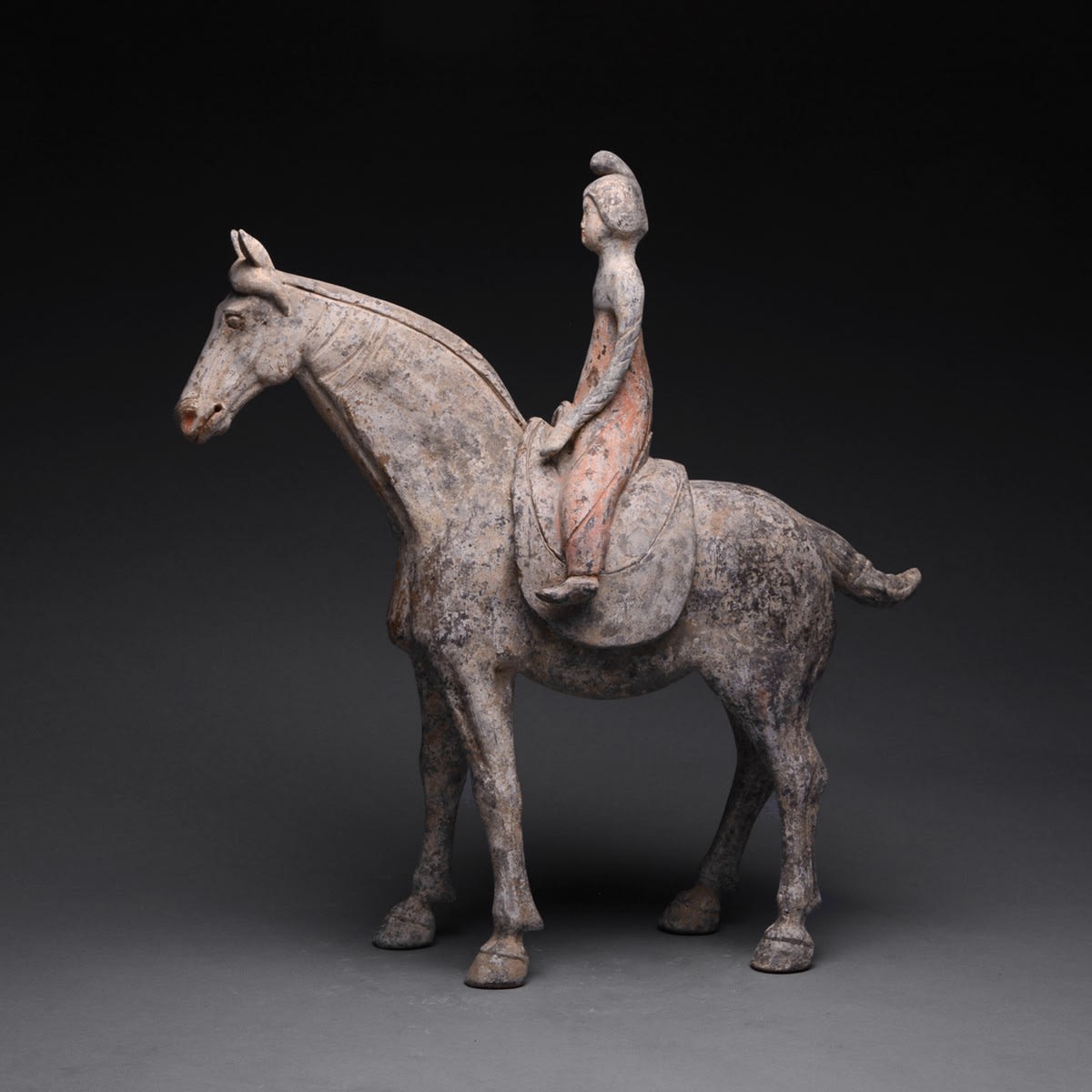Tang Painted Terracotta Horse with Removable Saddle and Lady Rider, 618 CE - 906 CE
Painted Terracotta
height 45.1 cm
height 17 3/4 in
height 17 3/4 in
H.1016
Further images
The T’ang Dynasty was an era of unrivalled wealth and luxury. The country was successfully reunified and the borders were expanded, pushing Chinese influence into new lands. Confucianism became a...
The T’ang Dynasty was an era of unrivalled wealth and luxury. The country was successfully reunified and the borders were expanded, pushing Chinese influence into new lands. Confucianism became a semi-religious instrument of the state; yet Buddhism continued to flourish, spreading into Korea and Japan. The arts reached new levels of sophistication. Poetry and literature flourished under the enlightened rulers. The Silk Road brought fortunes into China. Precious treasures were imported on the backs of camels from far away lands and bartered for Chinese silk, medicinal herbs, and pungent spices. T’ang China was a multicultural empire where foreign merchants from across Central Asia and the Middle East settled in the urban centers, foremost among them the thriving capital of Chang’an (modern X’ian), a bustling cosmopolitan center of over two million inhabitants. Foreign traders lived next to native artisans and both thrived. New ideas and exotic artistic forms followed alongside. The T’ang Dynasty was a cultural renaissance where many of the forms and objects we now associate with China were first created. Moreover, this period represents one of the greatest cultural outpourings in human history.
During the T’ang Dynasty, horses were revered, considered relatives of the mythical dragon. This veneration was well earned, for the speed and stamina of these majestic animals ensured the protection of the northern borders against barbarian invaders as well as enhancing communication capabilities between far away provinces, thereby aiding in the expansion of the empire. The need to import horses from Central Asia influenced the creation of the Silk Road. Thus, they were also prized for their rarity. Naturally then, horses became a status symbol for the aristocratic elite. Polo and other equestrian pastimes became popular. This sculpture, depicting a lady-in-waiting riding on the back of a horse, reveals this connection between nobility and the horse. Perhaps the most remarkable feature of this work is the removable saddle and rider that detach from the body of the horse in one piece. A striking amount of the original polychrome still remains intact, clearly visible in the lady’s red dress and lips. We can imagine this lady prancing around on this horse, perhaps taking part in an important ceremony. She wears a long-sleeved dress, a type of which was used in a popular dance where the lady swirls the excess fabric around in the air. Discovered buried inside a tomb, this work was supposed to accompany the deceased throughout the afterlife. The striking beauty of this work is even more impressive, considering that it was created specifically for interment and was not supposed to be seen by the living. Today, we marvel in the beauty of this sculpture as much as its tremendous history and intriguing legacy.
During the T’ang Dynasty, horses were revered, considered relatives of the mythical dragon. This veneration was well earned, for the speed and stamina of these majestic animals ensured the protection of the northern borders against barbarian invaders as well as enhancing communication capabilities between far away provinces, thereby aiding in the expansion of the empire. The need to import horses from Central Asia influenced the creation of the Silk Road. Thus, they were also prized for their rarity. Naturally then, horses became a status symbol for the aristocratic elite. Polo and other equestrian pastimes became popular. This sculpture, depicting a lady-in-waiting riding on the back of a horse, reveals this connection between nobility and the horse. Perhaps the most remarkable feature of this work is the removable saddle and rider that detach from the body of the horse in one piece. A striking amount of the original polychrome still remains intact, clearly visible in the lady’s red dress and lips. We can imagine this lady prancing around on this horse, perhaps taking part in an important ceremony. She wears a long-sleeved dress, a type of which was used in a popular dance where the lady swirls the excess fabric around in the air. Discovered buried inside a tomb, this work was supposed to accompany the deceased throughout the afterlife. The striking beauty of this work is even more impressive, considering that it was created specifically for interment and was not supposed to be seen by the living. Today, we marvel in the beauty of this sculpture as much as its tremendous history and intriguing legacy.







